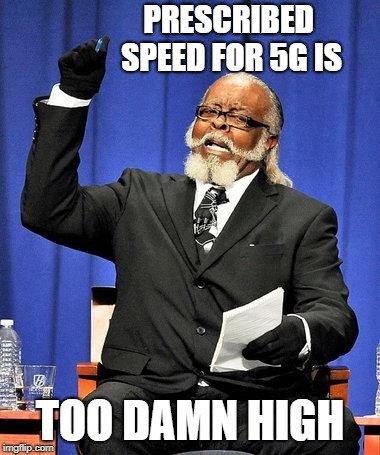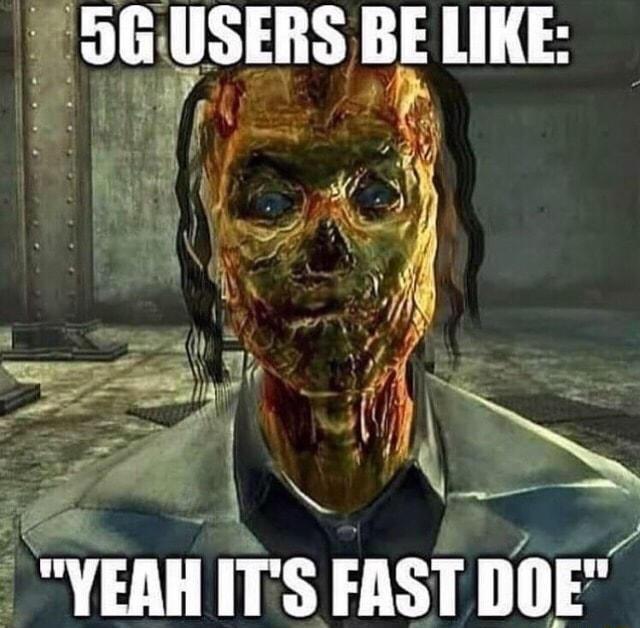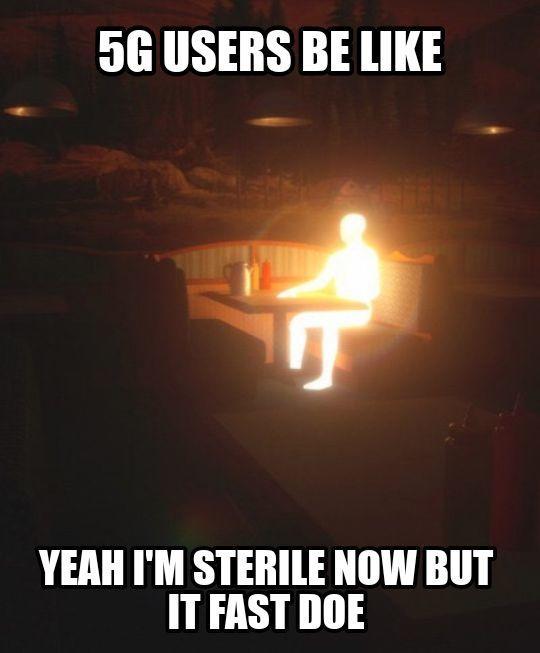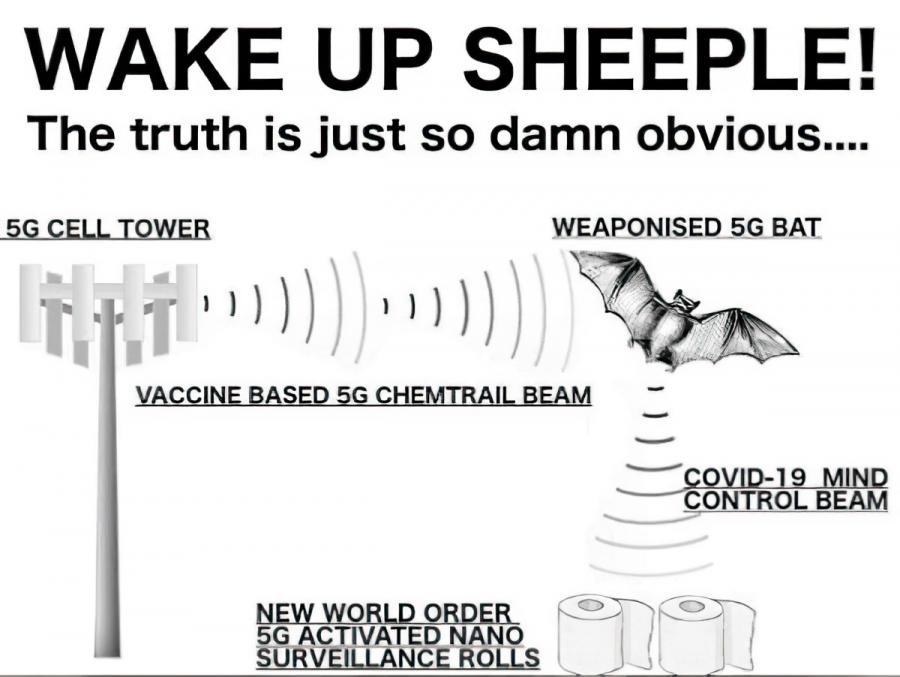
‘5G users be like’: (In)visibility as evidence in 5G conspiracy memes
Recently, 5G cell towers in various European countries have gone up in flames, presumably set on fire by individuals who claim that the, invisible to the human eye, electromagnetic waves emitted by such towers are harming their health. This belief can be considered a conspiracy theory as it involves stigmatized knowledge about a phenomenon for which there is a specific group of people or entity who claims to be exclusive aware of what is going on and attempts to promote their interests and bring about certain effects by disseminating this knowledge. Beliefs about 5G cell towers have also been related to the novel coronavirus, which is currently causing a global pandemic, based on the idea that Covid-19 is directly related to 5G-radiation as the virus causes health issues similar to those that these conspiracy theorists have already defined as resulting from 5G-radiation; hence the vandalizing of the cell towers.
This article delves into an investigation of two explicit 5G conspiracy memes drawing on various sources to define the concepts of conspiracy theories in the digital age, and to examine memes as a mode of disseminating such theories as well as (in)visibility as evidence of knowledge. Through this investigation, it asks, what is the role of (in)visibility as evidence within memes propagating the 5G and 5G-coronavirus conspiracy theories?
Conspiracy theories in the digital age
Barkun (2016) defines conspiracy theories as intellectual constructs, ‘‘templates imposed upon the world to give the appearance of order to events’’ (p. 1), attempting to explain a single event or even entire historical or global phenomena. Central within conspiracy theories is stigmatized knowledge, which involves knowledge claims that, despite being invalidated by ‘‘those institutions we rely upon to validate such claims’’ (Barkun, 2016, p. 1), circulate within a sub-culture of believers of a particular conspiracy as well as within the larger general culture of stigmatized knowledge-believers who are oftentimes suspicious of orthodoxies and the authorities advancing them (Barkun, 2016). Besides being about particular claims to knowledge, conspiracy theories are, then, also social constructs as they involve ‘‘socially organized ways of seeing and understanding events that are answerable to the distinctive interests of a particular social group’’ (Goodwin, as cited in Varis, 2019, p. 6).
Through the rise of the internet as a mass medium which enables new forms of communication, conspiracies can easily become mainstream. Mainstreaming is stimulated as individuals can create and circulate content on established platforms without censorship by gatekeepers and can thus establish authoritative knowledge (Barkun, 2016). At the same time, people from all over the world are enabled to collaborate online in discussing and bringing evidence to others on a large scale (Varis, 2018). This digitalized environment then influences the group formation of conspiracists and the spread of their theories as the multimodal affordances used in sharing and circulating knowledge affect people’s engagement and intertextual affiliation with information (Varis, 2018), which becomes increasingly seizable and persuasive.
Memes as a mode for ‘conspiracizing’
A particular digital mode used in the dissemination and discussion of conspiracy theories online is the multimodal medium of memes, referring to an amusing or interesting item, genre of items, idea, behaviour, or usage that widely spreads between persons within a culture through repetition, especially on social media (Merriam-Webster, n.d.). Drawing on specific conspiracies, memes can contribute to creating and circulating certain types of knowledge, and can function as ‘‘a specific logic for seeing and representing things and making claims to knowledge’’ (Varis, 2019, p. 6); consequently, they can ‘‘contribute to the creation of communities of knowledge where particular versions of reality become authoritative’’ (Varis, 2019, p. 5). Because of their limited frame, memes facilitate ‘bite-sized conspiracy theories’, but they can nonetheless be seen as presenting, oftentimes through their visual elements, evidence, which makes sense and becomes credible when its viewers rely on shared presuppositions (Varis, 2019).
Drawing on specific conspiracies, memes can contribute to creating and circulating certain types of knowledge.
The relatively recent 5G conspiracy theory in particular, and the sub-theory that connects 5G-ratiation to the outbreak of the coronavirus, also is and has been discussed through the digital mode of memes. Essentially, 5G is the newest form of mobile internet and, as a product of wireless technology, it emits waves, or radiofrequency radiation, through cell towers to and from mobile devices. To accommodate for the increase in frequency and demand of data traffic, this technology requires the installation of new cell towers, which have thus been targeted by conspiracy theorists as from 2016 onwards (Know Your Meme, 2020) they have developed conspiracies about 5G.
These conspiracy theories state that 5G technology and its electromagnetic waves cause harm to people's immune system, for instance hindering the intake of oxygen and causing symptoms such as headaches, exhaustion, focus issues, heart problems, and cancer (Pen, 2020). They have also supposedly even caused people to commit suicide (Heilweil, 2020). Other theories involve the claim that 5G is an instrument for governmental mind control (Heilweil, 2020), tapping into conspiracy theorists’ central belief in a mysterious "they" whose hidden power supposedly exercises all control and manipulates individuals (Barkun, 2016).
Dedicated 5G conspiracy memes: ‘fast doe’
The 5G conspiracy theory has been adopted and recontextualized in various existing memes, such as the ‘too damn high’ meme (see Figure 1), in which the maker claims that the speed of 5G is too high and therefore refers to the supposed harmful health effects of the technology as emphasized by its theorists; through this statement, the meme pleads for the need to reduce the frequency of the waves.

Figure 1. A 'too damn high' meme
Rather than arguing for the validity, or invalidity, of the knowledge put forward in such 5G conspiracy memes, what follows is an investigation of the layers of meaning embedded within one particular meme that is dedicated to the propagation of this conspiracy theory, which we shall call the ‘fast doe’ meme. This investigation entails exploring the meme’s claims to specific knowledge, highlighting the role of visibility and the evidence it represents within these claims, as well as the ‘‘claims to particular identities, as those propagating and circulating them occupy a specific knowledgeable position for themselves’’ (Varis, 2019, p. 4).
Figure 2. A 'fast doe' meme
Even though the ‘fast doe’ meme (e.g., see Figure 2) has been recontextualized in various versions with varying visual and textual elements, each version generally involves a consistent underlying message from a specific social group making a specific claim to knowledge. This is expressed through both the use of a particular visual element and the phrases "5G users be like" and some iteration of the catchphrase "it’s fast though".
Knowledge claim and identities. The specific knowledge claim within the message of this meme revolves around the 5G conspiracy theory and thus the idea that the waves of this technology cause health problems, pointing out how individuals who use it are somehow stupid. The first aspect of this claim is illustrated in the visual element of the meme as this is generally a human character with a melted or glowing face, possibly retrieved from pop culture references, which implies that the radiation of this technology essentially exposes individuals to radioactive energy and "fries" them, causing the health issues as described previously.
The creator of such a meme, as well as those conspiracists who take up the same belief, then frames this knowledge as factual, and with the addition of the phrase "5G users be like", identifies a group of others that the "fried" character personifies, distances themselves from using 5G, and presents an awareness which positions them as more knowledgeable than those who do use the technology. From this "authoritative" position, the poster creates social opposition between "I" or "us", those "in the know" regarding the reality of 5G, who oppose the installation and activation of the technology, and "them", the 5G users who adopt this technology. In this opposition, the "us" group then positions "them" as dumb by presenting them as unaware of or consciously ignoring the health risks because they prioritize fast internet over their wellbeing. This typification of these "others" is further expressed in the meme through the linguistically "incorrect" textual elements through which the "us" group represents a response offered by users of 5G, thereby mocking them, using phrases such as "be like" and "doe".
Ultimately, the understanding and adoption of this meme relies on intertextual links and shared presuppositions, or ‘‘taken-for-granted assumptions and knowledge resources’’ (Varis, 2019, p. 20) between the poster and their fellow believers, the repetition of which can confirm their views and solidify the conspiracy community (Varis, 2019). This meme is, however, also understandable regardless of whether one agrees with the conspiracy or is conscious of using 5G, as it only requires familiarity with the claims made on the harm caused by the electromagnetic waves transmitted through the 5G network.
Visual evidence can have a critical function in conspiracies as vision is a metaphor of knowledge and can be highly persuasive.
(In)visibility. The knowledge claim within this 5G conspiracy theory and the ‘fast doe’ meme is strengthened in credibility and persuasiveness by the ‘making-visible-of’, which in general is central in conspiracy theories and the evidence displayed within them. Visual evidence can have a critical function in conspiracies as vision is a metaphor of knowledge (Brighenti, 2007) and can be highly persuasive (Varis, 2018). Addressing the social process of making something visible, the key features of visibility are relationship, between seeing and being seen; strategy, the choices made to be (in)visible; field, having to do with determining the thresholds of visibility in what becomes visible to us and what does not; and process, the acting on the properties of the field and thus affecting visibility (Brighenti, 2007).
Within the theorizing of 5G conspiracies visibility is thus also central as, besides pointing out the obviously physical cell towers through which 5G is transmitted, its theorists attempt to illustrate the invisible radiation emitted by the technology. Through the meme as a multimodal medium 5G conspiracists are enabled to use the strategy of implementing an, albeit unrealistic, visual element in their message to illustrate something that is invisible to the human eye. This process of theorizing about and attributing meaning to the invisible, turning it into evidence, then unfolds as the meme theorists visually and "physically" represent both the existence of the 5G network in general and the invisible effects of its waves through an image of a melting or glowing 5G user. This is sometimes further emphasized by the textual additions within the meme with which the internal health risks are pointed out. In some iterations of the meme, this is explicit such as in Figure 3, which specifically refers to sterility.
Figure 3. A 'fast doe' meme that explicitly refers to sterility as a harmful effect of 5G-radiation
Within the evidential capacities of this visibility, the invisible is intrinsic to the visible as it ‘‘connects physically the subject-observer to the object-observed’’ (Brighenti, 2007, p. 328). As visibility lies at the intersection of the domains of aesthetics or perception and politics or power-relations, the conspiracy theorists can tap into the recognition gained through social visibility, both from fellow believers and from those familiar with the 5G conspiracy. As conspiracizing and visibility are both intertwined with social processes in which the theorizing relies on shared facts and knowledge, the theorists, who are "in the know" about the truth of 5G, can adopt this strategy of visualizing the invisible to create evidence of their knowledge. They thus act within the field and attempt to present this particular knowledge claim to 5G users and persuade them of their beliefs through the meme.
Furthermore, vision gains legitimacy through differentiation, which involves the idea that a certain form of authority is established as each individual has different perceptions and interpretations of their visual experiences (Scott, 1991). This then contributes to the challenge of debunking this conspiracy because, as there is no physical proof of 5G radiation, it is easy for theorists to assign a mode of visualization to their interpretation of reality and thus generate evidence. As "seeing is believing" is impossible in this particular context, theorists can thus "see" a legitimate truth in something that is invisible: as the 5G network is invisible it is easy to make claims of knowledge regarding its existence and the alleged internal, initially invisible, health effects caused by it.
The 5G-coronavirus conspiracy
When the pandemic of Covid-19 emerged and was first connected to 5G by a Belgian GP (Temperton, 2020), theorists started to further develop the 5G conspiracy into new and additional conspiracies. They did so by drawing on similar knowledge claims and using a strategy of making the invisible visible in order to create and emphasize connections between the health issues associated with 5G and the virus. Spreading rapidly online through various Facebook groups and re-posting celebrities (Anderson, 2020), who advanced its spread as their authority promotes a pseudo-validity (Barkun, 2016), these sub-theories include the ideas that 5G causes Covid-19 or worsens its effects, that Covid-19 originated in the Chinese region of Wuhan as 5G was first installed there (van den Berg, 2020), that the virus is used as a cover-up for the installation of 5G towers, and that 5G and Covid-19 are part of a depopulation scheme (Heilweil, 2020).
Ultimately, ‘‘almost all of the conspiracy theory posts linking 5G to coronavirus make use of tired, debunked tropes about non-ionising radiation, chemtrails and ‘deep state’ plots to use vaccines to control people and remotely shut down their organs’’ (Temperton, 2020, para. 8). Such theories aid in finding a scapegoat for such "vague" health issues and the chaotic situation caused by Covid-19, however unrealistic or unproveable they may be (Anderson, 2020).
5G-coronavirus conspiracy memes: ‘the truth’
Knowledge claim and identities. Whereas the ‘fast doe’ meme resurfaced with the emerging of the 5G-coronavirus conspiracy, specific memes have also been dedicated to this latter conspiracy specifically. One such meme, which we will call ‘the truth’ (see figure 4), is retrieved from the profile @flatearthtruthseeker on Instagram, an account that (ironically?) presents itself as a "truth seeker" and whose posts make claims to "truth" and knowledge. This (parody?) meme represents this 5G-Covid conspiracy through an illustration of a 5G tower, a "weaponised" bat, and toilet paper, all connected with symbols of radiation, along with a textual description elaborating on the meaning of these visuals and the relation between them. Through this, the intertextual links between the 5G conspiracy, Covid-19, and intersections with other conspiracy theories and knowledge claims within this meme are revealed, which include chemtrails, the idea that the trails left by airplanes are purposely harmful. This is linked, for instance, also to the idea that governments are attempting to control the world's population. Anti-vaxxing, the idea that vaccinations are harmful rather than beneficial for one’s health and can cause autism, is also a related stance. Finally, general schemes of governmental "deep state" mind control that people need to "wake up" from according to the theorists are also found in the meme.
Figure 4. 'The truth'
In a similar approach as with the ‘fast doe’ meme, the maker of this 5G-coronavirus conspiracy meme presents themselves as being in a more privileged position than non-believers as they claim to have access to specific crucial information and knowledge that these others are not seeing. Specifically, in this meme, the creator is "in the know" as they emphasize the "the truth" of 5G affecting Covid-19 and perhaps the existence of a governmental control scheme which the herd-like public or so-called "sheeple" ‘‘refuse to look for, see or accept’’ (Varis, 2019, p. 4). The theorists differentiate themselves from those individuals they consider ignorant because they do not believe in this conspiracy, suggesting that they blindly accept what they are being told, i.e. that Covid-19 virus is unrelated to 5G.
(In)visibility and the coronavirus. The relationship between visibility and invisibility, as evident in the "general" 5G-conspiracy theory and the ‘fast doe’ meme, is also significant within the context of this specific theory that links 5G and the supposed health issues caused by its radioelectric waves to the emergence and spread of the novel coronavirus. This conspiracy then theorizes on a layer of invisibility and knowledge in addition to the idea that 5G-waves are associated with health issues, as the Covid-19 virus and its symptoms specifically are also a phenomenon initially invisible to human eye.
This strategy of making the invisible visible further reveals the relation between the various conspiracies highlighted within the meme.
Within the ‘the truth’ meme the evidence against 5G in general is re-used within a new context whilst simultaneously emphasizing the meaning of the connection between 5G and the coronavirus through a visual representation of symbolic wireless waves and the objects emitting or affected by these waves. This presents an image which is more direct than the glowing person of the ‘fast doe’ meme. This strategy of making the invisible visible further reveals the relation between the various conspiracies highlighted within the meme, illustrating how these and their effects affect each other and are intertwined within a larger, perhaps "deep state"-related network.
Additionally, invisibility is theorized in this meme as the invisible is made visible through its connection to conspiracies that revolve around material objects that are visible, tapping into relationships between concepts which humans can visually and physically perceive. Consequently, this broadens the field and thresholds of visibility as to what is visible to us and in what ways, which then contributes to the process of persuasion within the dissemination of the meme and the conspiracy or "reality" it conveys.
Conclusion
Reflecting on the question posed in the beginning of this article, after discussing the role of (in)visibility as evidence within memes promoting 5G conspiracies, an answer can be formulated based on the performed explorative analysis. Focusing on the multimodal nature of internet memes, this investigation emphasized how visibility is used as evidence in the knowledge claims made by conspiracists about the 5G and 5G-coronavirus theories.
The conspiracy theories essentially involve the ideas that the radiation emited by 5G technology is harmful to people's health and that it is related to the outbreak of Covid-19. Analyzing the communication of this idea within two memes promoting it, this analysis revealed how connections between invisibility and visibility are established and adopted by theorists to provide evidence for their authoritative and "truthful" knowledge claims. Presenting these claims through a strategy of making the invisible visible through specific, easy to understand, and simplified visuals then provides new perspectives, which potentially amount to attracting individuals who are not yet believers, and which can strengthen the beliefs of and support for the theorists.
This strategy further involves the theorists visually representing and personifying the invisible effects of 5G radiation and explicitly naming its health risks. They then use the power of visibility to create evidence and construct their knowledgeable position to persuade others. This visualization has two further effects. First, that it facilitates the presentation of a specific phenomenon since, when discussing something that is invisible, there are ways to attach meaning to it, for instance by pointing to its supposed effects in the visible domain. Secondly, it eases personal interpretations of "the truth" as visibility involves differences between individuals and their personal perceptions of visuals, and in this context of invisibility, the standard of "seeing is believing" is initially impossible to achieve. The two further strategies which broaden and interact with the field of invisibility are the tapping into and creating of a network with existing conspiracies which already have visual evidence associated within them, and the creating of direct relations to physical and visual objects that individuals are already familiar with.
This analysis can be further extended by investigating additional memes which explicitly address the conspiracy theory related to 5G, especially highlighting those emphasizing 5G's relation to the coronavirus. This will enable further explorations into the role of visibility and the way it is mobilized within this specific conspiracy theory or within knowledge claims about its relation to Covid-19 specifically.
References
Anderson, I. (2020, July 1). Why the 5G coronavirus conspiracy theory is false – video explainer. The Guardian.
Barkun, M. (2016). Conspiracy Theories as Stigmatized Knowledge. Diogenes.
van den Berg, E. (2020, February 27). ‘5G veroorzaakt corona’: nepnieuws dat in 30 dagen de hele wereld bereikte. Npo3.
Brighenti, A. (2007). Visibility. Current Sociology, 55(3), 323–342.
Flat Earth Truth Seeker [@flatearthtruthseeker]. (2020, March 27). Open your eyes. The truth is out there. Seek it. #flatearth #flatearthsociety [Instagram photo].
Heilweil, R. (2020, April 24). The conspiracy theory about 5G causing coronavirus, explained. Vox.
Know Your Meme. (2019). The Rent is Too Damn High / Jimmy McMillan [Meme].
Know Your Meme. (2020). It’s fast doe [Meme].
meme. (n.d.). In Merriam-Webster.
Pen, H. (2020, January 25). Honderden demonstranten op de Dam: ‘5G maakt alle leven kapot.’ Het Parool.
Scott, J. W. (1991). The evidence of Experience. Critical Inquiry, 17(4), 773–797.
Temperton, J. (2020, April 9). How the 5G coronavirus conspiracy theory tore through the internet. WIRED UK.
Varis, P. (2018). Dr. Piia Varis on conspiracy theories and digital culture [Video file]. Diggit Magazine.
Varis, P. (2019). Conspiracy theorising online: Memes as a conspiracy theory genre. Tilburg Papers in Culture Studies, 238.


